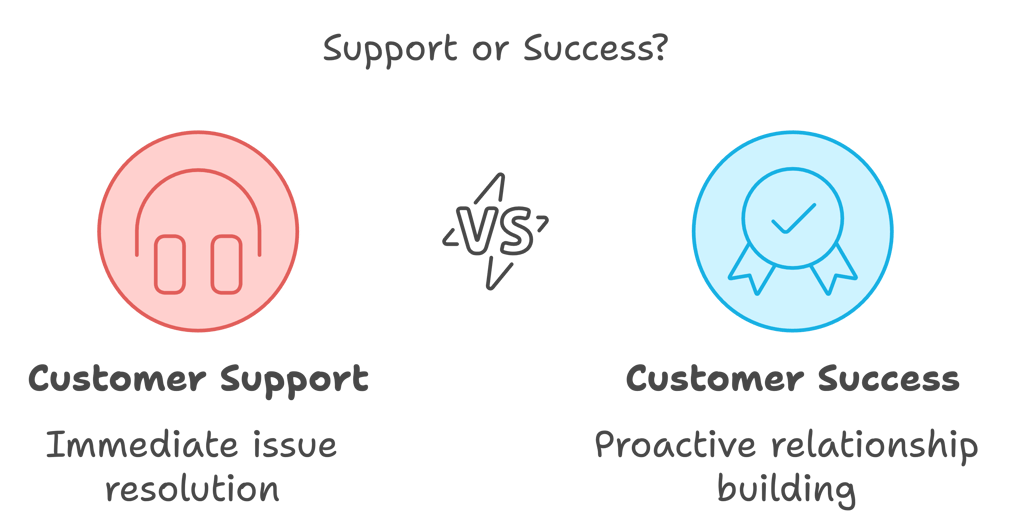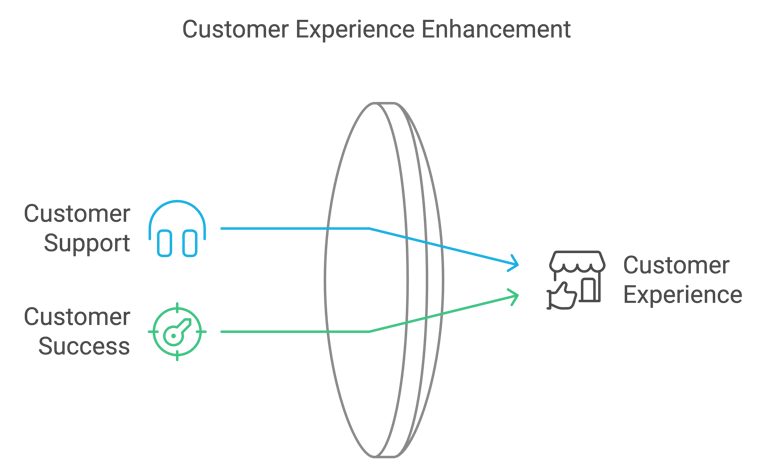Customer Success VS Customer Support فهم الفروقات الرئيسية بين نجاح العملاء ودعم العملاء
10/3/20243 min read


Understanding the Key Differences Between Customer Success and Customer Support
In the SaaS world, Customer Success (CS) and Customer Support are both critical roles that ensure business growth and customer satisfaction. While they share the common goal of improving the customer experience, these two functions have distinct objectives and approaches. Here’s a breakdown of the main differences:
1. Proactivity vs. Reactivity
Customer Success: CS is a proactive function, centered around building long-term relationships with customers. Its primary objective is to help customers achieve their desired outcomes with a product or service. CS professionals anticipate customer needs, providing tailored solutions to maximize value and foster customer engagement.
Customer Support: Customer Support, on the other hand, is a reactive function. The team addresses immediate customer issues and resolves technical problems as they arise. Support ensures smooth operations but engages mostly when customers encounter challenges.
2. Retention and Renewals
Customer Success: Retention is a key performance metric for CS teams, who are responsible for renewing customer subscriptions. They focus on reducing churn and delivering continuous value, keeping customers satisfied throughout their journey.
Customer Support: While Support plays a crucial role in satisfaction, it is primarily measured by Customer Satisfaction (CSAT) and Service Level Agreement (SLA) compliance. Retention and renewals are not usually part of their performance metrics.
3. Revenue Generation
Customer Success: CS is not only responsible for customer retention but also for generating revenue through renewals, upselling, and cross-selling opportunities. This means CS teams are integral to the Net Dollar Retention (NDR) metric, as they help increase revenue from existing customers by ensuring satisfaction and expanding the value of the product or service.
Customer Support: Support teams typically do not contribute directly to revenue. In some cases, they may assist in revenue generation through handling change requests or service re-implementation. However, their core function remains solving technical or business issues.
4. Health Scores vs. CSAT & SLA
Customer Success: CS teams manage and improve the health scores of customers. These scores reflect multiple factors like product adoption, engagement, and satisfaction (Net Promoter Score [NPS]). High health scores indicate that customers are achieving success with the product.
Customer Support: While Support contributes to overall customer health by resolving issues, they do not own the health score. Instead, their success is measured by CSAT scores and meeting SLA terms.
5. Adoption Rates
Customer Success: The CS team is responsible for increasing customer adoption rates by enabling and educating customers about the product. This focus on education and enablement enhances product stickiness, usage, and return on investment (ROI).
Customer Support: In contrast, the Support team does not proactively drive product adoption. Their role is primarily reactive, assisting customers as they encounter challenges or inquiries about the product.
6. Customer Advocacy
Customer Success: CS professionals serve as customer advocates within the company. They work with internal teams (Product, Engineering, etc.) to ensure that customer feedback informs the product roadmap, leading to long-term success.
Customer Support: Although Support also advocates for the customer, their interactions are typically more transactional and focused on solving specific issues.
Conclusion
Although Customer Success and Customer Support have different focuses—CS works to build long-term relationships and provide value, while Support addresses immediate concerns—they are interdependent functions. Both must collaborate closely and maintain open communication with teams like Product, Engineering, and Onboarding to ensure a seamless customer experience.
While no function is inherently more important than the other, in my personal judgment, some of the best Customer Success Managers often come from a Customer Support background. These professionals bring a combination of technical expertise, customer-centric mindset, and interpersonal skills that enable them to excel in driving customer success and fostering long-term relationships.
By understanding these differences and leveraging the strengths of both teams, businesses can drive customer retention, customer experience, and sustainable growth.
فهم الفروقات الرئيسية بين نجاح العملاء ودعم العملاء
في عالم البرمجيات كخدمة (SaaS)، تعتبر أدوار نجاح العملاء (CS) ودعم العملاء ذات أهمية حيوية، حيث تضمن نمو الأعمال ورضا العملاء. على الرغم من أن كلا الدورين يشتركان في الهدف المشترك المتمثل في تحسين تجربة العملاء، إلا أن لهما أهدافاً ونهجاً مختلفين. إليك تفصيل للفروقات الرئيسية:
1. الاستباقية مقابل رد الفعل
نجاح العملاء: يُعتبر نجاح العملاء وظيفة استباقية، تركز على بناء علاقات طويلة الأمد مع العملاء. الهدف الأساسي هو مساعدة العملاء على تحقيق نتائجهم المرجوة باستخدام المنتج أو الخدمة. يتوقع محترفو نجاح العملاء احتياجات العملاء، ويوفرون حلولاً مخصصة لإضافة القيمة وتعزيز التفاعل مع العملاء.
دعم العملاء: من ناحية أخرى، يُعتبر دعم العملاء وظيفة رد فعل. يقوم الفريق بمعالجة مشاكل العملاء الفورية وحل القضايا الفنية كما تظهر. يضمن الدعم سلاسة العمليات ولكن يتفاعل في الغالب عندما يواجه العملاء تحديات او استفسارات.
2. الاحتفاظ وتجديد الاشتراكات
نجاح العملاء: يُعتبر الاحتفاظ أحد مؤشرات الأداء الرئيسية لفرق نجاح العملاء، التي تكون مسؤولة عن تجديد اشتراكات العملاء. تركز هذه الفرق على تقليل فقدان العملاء وتقديم قيمة مستمرة و إبرازها، مما يُبقي العملاء راضين طوال رحلتهم مع الشركة كعميل.
دعم العملاء: على الرغم من أن الدعم يلعب دوراً حيوياً في رضا العملاء، إلا أنه يقاس بشكل أساسي رضا العملاء (CSAT) او غيرها وامتثال اتفاقية مستوى الخدمة (SLA). عادةً ما لا تكون التجديدات ضمن مقاييس أدائهم.
3. الإيرادات المالية
نجاح العملاء: يعد فريق نجاح العملاء مسؤولاً ليس فقط عن الاحتفاظ بالعملاء ولكن أيضًا عن توليد الإيرادات المالية من خلال التجديدات والبيع الإضافي والبيع المتقاطع. يعني ذلك أن فرق نجاح العملاء تلعب دورًا أساسيًا في مقياس (NDR)، حيث تساعد على زيادة ونمو الإيرادات من العملاء الحاليين من خلال ضمان الرضا وإبراز قيمة المنتج أو الخدمة.
دعم العملاء: لا تساهم فرق الدعم عادةً في الإيرادات المالية بشكل مباشر. في بعض الحالات، قد تساعد في الإيرادات المالية من خلال ايرادات واردة من طلبات التغيير أو إعادة التنفيذ. ومع ذلك، تظل وظيفتها الأساسية هي حل القضايا الفنية أو التجارية.
4. معدلات صحة العملاء مقابل CSAT وSLA
نجاح العملاء: تدير فرق نجاح العملاء وتعمل على تحسين معدلات الصحة للعملاء. تعكس هذه الدرجات عوامل متعددة مثل اعتماد المنتج، والتفاعل، والرضا [NPS] وعمر العميل. تشير درجات الصحة العالية إلى أن العملاء يحققون النجاح مع المنتج.
دعم العملاء: على الرغم من أن الدعم يساهم في الصحة العامة للعملاء من خلال حل المشكلات، إلا أنهم ليسوا المسؤولين بالدرجة الاولى عن درجات الصحة. بدلاً من ذلك، يتم قياس نجاحهم بواسطة درجات CSAT وامتثال SLA.
5. مستوى تبني والاعتماد على المنتج
نجاح العملاء: فريق نجاح العملاء مسؤول عن زيادة معدلات اعتماد العملاء على المنتج من خلال تمكين العملاء وتعليمهم حول المنتج. يركز هذا على التعليم والدعم لتعزيز اعتمادية وديمومة المنتج عند العملاء، وزيادة الاستخدام، والعائد على الاستثمار (ROI).
دعم العملاء: في المقابل، لا يُعتبر فريق الدعم استباقيًا في دفع اعتماد المنتج. دورهم هو التفاعل بشكل أساسي، مساعدين العملاء عندما يواجهون تحديات أو استفسارات حول المنتج.
6. صوت العميل
نجاح العملاء: يعمل محترفو نجاح العملاء ك صوت و مدافعين عن العميل داخل الشركة. يعملون مع الفرق الداخلية (المنتج، البرمجة، إلخ) لضمان أن متطلبات العملاء سوف تعطى تدرس ضمن خارطة طريق المنتج، مما يؤدي إلى النجاح على المدى الطويل وتجربة عميل ممتازة.
دعم العملاء: على الرغم من أن الدعم أيضًا يدافع عن العملاء، إلا أن تفاعلاتهم عادةً ما تكون تعتمد على عمليات وتركز على حل قضايا معينة.
الخاتمة والتوصيات
على الرغم من أن نجاح العملاء ودعم العملاء لهما ركائز مختلفة—فإن نجاح العملاء يعمل على بناء علاقات طويلة الأمد وإضافة القيمة للمنتج، بينما الدعم يعالج القضايا الفورية—إلا أن كلاهما وظائف مترابطة. يجب على كلا الفريقين التعاون عن كثب والحفاظ على التواصل المفتوح مع الفرق مثل المنتج والفريق التقني والتطبيق لضمان تجربة سلسة للعملاء.
بينما لا توجد وظيفة أكثر أهمية من الأخرى، في حكم شخصي، يأتي بعض من أفضل مديري نجاح العملاء من خلفية دعم العملاء. يجلب هؤلاء المحترفون مجموعة من الخبرة التقنية، والعقلية المرتكزة على العميل، ومهارات التواصل التي تمكنهم من النجاح في قيادة نجاح العملاء وتعزيز العلاقات طويلة الأمد.
من خلال فهم هذه الفروقات واستغلال نقاط القوة في كلا الفريقين، يمكن للشركات أن تحقق الاحتفاظ بالعملاء، وتجربة العميل، ونمو الايرادات المستدام.



